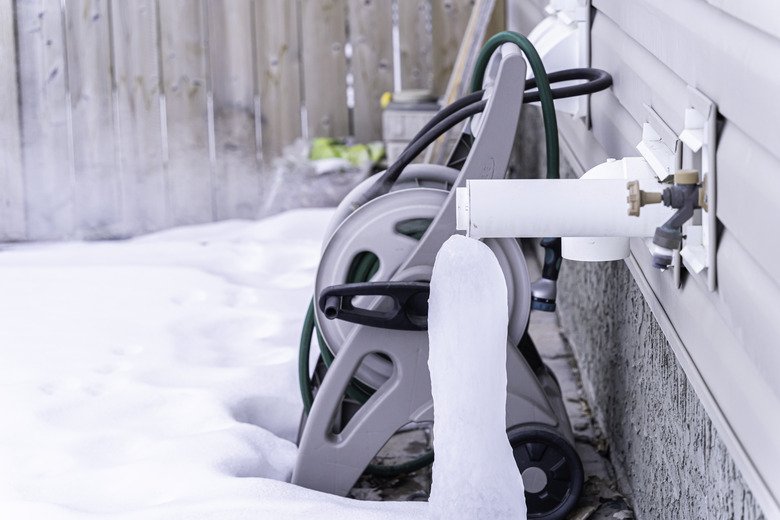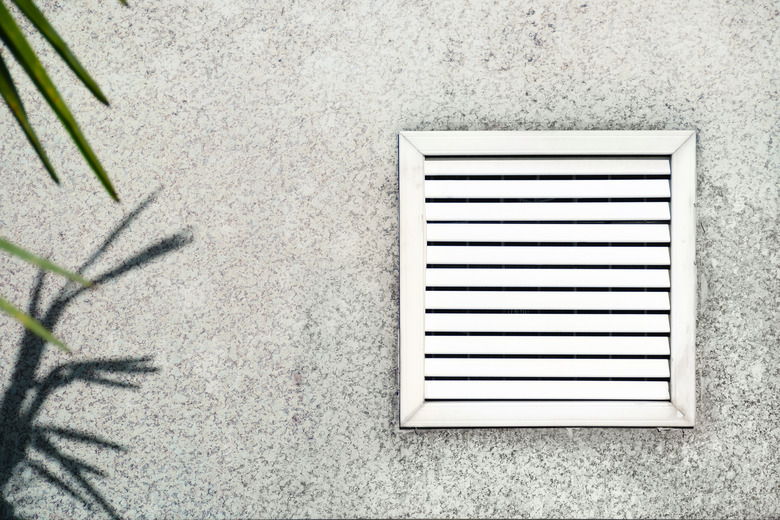Here's Why High-Efficiency Furnace Venting Is Different Than A Conventional Furnace
A high-efficiency furnace is a relatively new innovation in residential HVAC technology. When furnaces for forced-air home heating systems came into use, they all initially vented their exhaust gases in a very traditional way, similar to how wood-burning fireplaces are vented. The exhaust gases were vented vertically into a brick chimney, sometimes lined with a metal flue, that ran up through the house and out the roof. From 1935, when forced-air systems were invented, into the energy crisis years of the 1980s, this was the traditional venting system of all fuel-burning forced-air furnaces.
During this period, even the best conventional furnace units achieved only about 60 to 70 percent efficiency at best — meaning 30 to 40 percent of the energy went up the chimney as wasted heat. At the point where high energy costs made it viable, manufacturers began to develop a series of new furnace designs that burned more efficiently. Some of these designs are long since obsolete (the Carrier company's Pulse furnace, for example), but out of this period of innovation came the basic design that today governs the modern high-efficiency furnaces capable of achieving efficiency ratings of 90 to 98 percent.
High-efficiency furnaces that achieve ratings of 90 percent or higher became increasingly popular starting around 2010. By 2012, for example, 35 percent of all furnaces sold had energy-efficiency ratings of 90 percent or higher. If your furnace is less than 10 years old, it's quite possible you already have a high-efficiency unit, especially if you live in a cold-winter climate. If you are planning to install a new furnace — or you live in a new home — it's very likely it will be a high-efficiency model.
High-Efficiency Furnace Innovations
High-Efficiency Furnace Innovations
The 1980s and 1990s saw a variety of innovations that were necessary to improve the efficiency of forced-air furnaces:
- Hot-surface ignition: Older furnaces used standing pilot lights that constantly burned a small amount of fuel. This feature was eventually replaced by electronic ignition that ignites the gas only when a signal was sent to the furnace. The most efficient method of all is found in modern high-efficiency furnaces, where the fuel is ignited by a hot-surface ignitor device that creates the high temperatures necessary for igniting the fuel.
- "In-shot" burners: Older furnaces used a fairly passive burner flame similar to what is found on a gas stove. A modern high-efficiency furnace, on the other hand, uses a burner that forcefully blows the flame into the heat exchanger in a manner that extracts the greatest-possible energy from the fuel.
- Duel heat exchanger: Instead of allowing hot exhaust gases to vent by simple physics (hot air rises) up the chimney, high-efficiency furnaces use a secondary heat exchanger to pull much more of the heat from the exhaust before venting it out of the house. The exhaust gases in a modern furnace are quite cool by the time they leave the system.
- Draft induction fan: Because the exhaust gases in a modern efficient furnace have been drained of virtually all their heat, there is no longer sufficient energy to create the convection current that allows the gases to naturally rise into a chimney. Thus, a secondary draft induction fan is necessary to create a draft to move the exhaust fumes into the vent pipe.
Nowhere, however, are the innovations for high-efficiency furnaces more important than those required for the furnace's venting system.
Standard-Efficiency vs. High-Efficiency Venting
Standard-Efficiency vs. High-Efficiency Venting
A standard-efficiency or midefficiency furnace may waste some energy, but the venting system itself is a marvel of simple physics. Because the exhaust gases are so hot, they rise quite naturally into a vertical flue that runs up a standard chimney and out of the house. No mechanical assistance whatsoever is required (although some older furnaces have draft inducer fans that push exhaust up the chimney).
If your furnace is an older low-efficiency or medium-efficiency unit (below 90 percent efficiency), it probably still vents in this way. It is increasingly rare, though, to see new furnaces of this type, even though 80 percent is still the Department of Energy's official efficiency minimum for warm-winter zones.
High-efficiency furnaces, on the other hand, require some improved technology in order to vent properly. These furnaces are known as "condensing furnaces" since one byproduct of extremely high efficiency is that condensed water is produced as the last calories of heat are wrung from the exhaust gases. Thus, these furnaces always have a drainage tube that runs to a floor drain or other drain fixture.
Another side effect of high-efficiency combustion is that the gases are so cool that they have no natural convection that allows the fumes to flow up a chimney. Thus, these furnaces won't vent at all unless there is an additional fan motor — called a draft induction fan — to draw the exhaust fumes into the flue.
Finally, another unfortunate side effect of high-efficiency burning is that the remaining exhaust gases become a highly corrosive mixture of carbon dioxide and acidic moisture. This exhaust gas is so corrosive that it quickly destroys the chimney mortar and the metal in the flues used to vent older furnaces.
To accommodate the unique nature of exhaust gases in a high-efficiency condensing furnace, the exhaust is typically vented through the sidewall of the home through PVC plastic pipes, not metal. This is one of the easiest ways to determine if a home has a high-efficiency furnace — look for the presence of one or two PVC pipes exiting the house at roughly the same level as the furnace. (ABS or CPVC pipe is also sometimes used, though PVC is more common.)
Sidewall Furnace Venting: One- or Two-Pipe Systems
Sidewall Furnace Venting: One- or Two-Pipe Systems
Sidewall venting for a high-efficiency condensing furnace can be done with two different types of installation: one-pipe systems or two-pipe systems.
Two-pipe venting is often preferable, especially in modern houses that are extremely airtight. In this system, often referred to as a direct vent installation, one of the PVC pipes draws in fresh outdoor air to feed to the furnace's combustion. This is usually referred to as the air-intake pipe, or simply the intake pipe. The other PVC pipe is the exhaust pipe, which carries out the spent exhaust gases from the furnace.
Some installations look like single-pipe systems but are actually two-pipe systems because they use a special double-walled concentric pipe that brings in fresh air along one sealed chamber of the pipe while exhausting through the other chamber. This concentric vent looks like a one-pipe system, but it's actually a two-pipe installation.
In one-pipe systems, the furnace draws in ambient air from inside the home to provide the air for fuel combustion. Sometimes, the installation technicians will install a secondary vent in the utility room or basement that simply allows outdoor air into the room to ensure that the furnace has enough fresh air. This is especially true in the most modern energy-efficient homes that are very airtight. It is less critical in older homes, which are naturally drafty in a way that ensures sufficient fresh air will be present.
Two-pipe installations are regarded as more efficient and are therefore preferable, but one-pipe installations are allowed by most building codes. Most new furnaces, in fact, can be adapted for either one-pipe or two-pipe installation. Whichever method is used, it is quite crucial that the vent pipes be installed correctly — airtight and with the proper slope — in order for the furnace to operate safely.
It's also important that the air intake pipe be positioned so that the air drawn in is truly fresh and not contaminated by fumes from any exhaust pipes used for the furnace or water heater. This can be tricky in townhouses or condominiums, where the outer wall for the utility room is fairly limited. Thus, furnace installation is usually a job for a licensed contractor. Some communities forbid homeowners from doing any of this work, and where DIY installation is allowed, you can expect the inspection process to be very rigorous.
References
- Presidential Heating & Air Conditioning: High Efficiency Furnace Venting: What You Need to Know
- Weather Tech Heating & Cooling: Ventilation
- Structure Tech: Can You Install a High-Efficiency Furnace With Only One Pipe?
- Air Conditioning Heating Refrigeration – The News: The 1990s – Technological Breakthroughs and Higher Efficiencies
- U.S. Energy Information Administration: Gas Furnace Efficiency Has Large Implications for Residential Natural Gas Use

